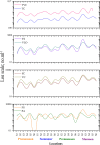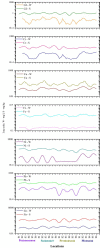Biomonitoring along the Tropical Southern Indian Coast with Multiple Biomarkers
- PMID: 27941969
- PMCID: PMC5152820
- DOI: 10.1371/journal.pone.0154105
Biomonitoring along the Tropical Southern Indian Coast with Multiple Biomarkers
Abstract
We assessed the spatial and temporal variations of pollution indicators and geochemical and trace metal parameters (23 in total) from water and sediment (144 samples) of three different eco-niches (beach, fishing harbor, and estuary) in larger coastal cities of southern India (Cuddalore and Pondicherry) for one year. A total of 120 marine Pseudomonas isolates were challenged against different concentrations of copper solutions and 10 different antibiotics in heavy metal and antibiotic resistance approaches, respectively. The study shows that 4.16% of the isolates could survive in 250 mM of copper; 70% were resistant to minimum concentrations. Strains were resistant (98.4%) to at least one antibiotic in Cuddalore compared to the Pondicherry (78.4%) region. Pollution index (PI) (0-14.55) and antibiotic resistance index (ARI) (0.05-0.10) ratio indicated that high bacterial and antibiotic loads were released into the coastal environment. The degree of trace metal contamination in sediments were calculated by enrichment factor (EF), contamination factor (CF), pollution load index (PLI), and geo-accumulation index (Igeo). Statistical parameters like two-way analysis of variance (ANOVA), correlation, factor analysis and scatter matrix tools were employed between the 23 parameters in order to find sources, pathways, disparities and interactions of environmental pollutants. It indicates that geochemical and biological parameters were not strongly associated with each other (except a few) and were affected by different sources. Factor analysis elucidated, 'microbe-metal' interaction (Factor 1-48.86%), 'anthropogenic' factor (Factor 2-13.23%) and 'Pseudomonas-Cadmium' factor (Factor 3-11.74%), respectively.
Conflict of interest statement
The authors have declared that no competing interests exist.
Figures





References
-
- Clark A, Turner T, Dorothy KP, Goutham J, Kalavati C, Rajanna B. Health hazards due to pollution of waters along the coast of Visakhapatnam, east coast of India. Ecotoxicology and Environmental Safety. 2003;56: 390–397. - PubMed
-
- Ashbolt N, Grohmann G, Kueh C. Significance of specific bacterial pathogens in the assessment of polluted receiving waters of Sydney. Water Science and Technology 27: 449–452.
MeSH terms
Substances
LinkOut - more resources
Full Text Sources
Other Literature Sources
Research Materials
Miscellaneous

